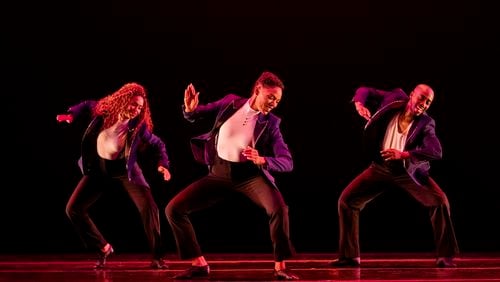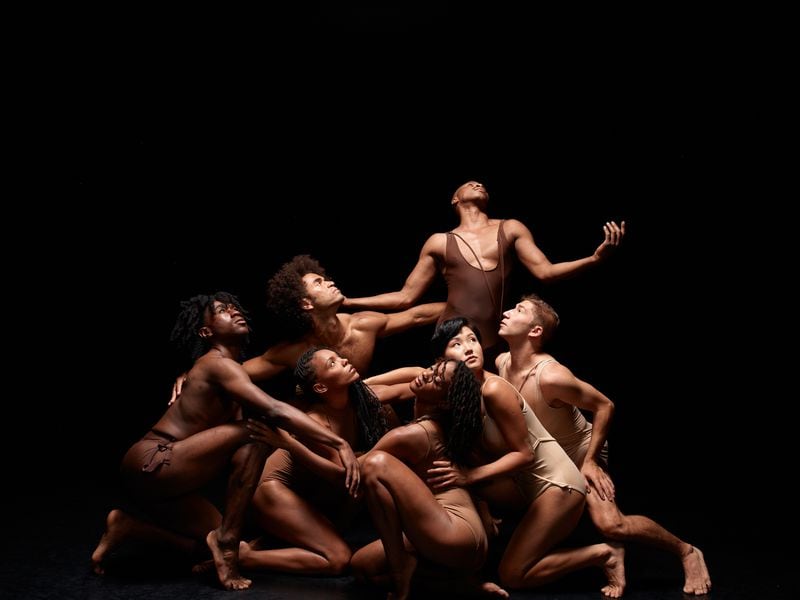Alvin Ailey American Dance Theater took the stage at the Fox Theatre last weekend, its first Atlanta engagement since February 2020, just before the pandemic shutdown. In opening remarks introducing the Saturday evening performance, artistic director Robert Battle warmly acknowledged Atlanta as Ailey’s second home, and audiences welcomed dancers back with open arms, thunderous applause, and cheers and whistles of appreciation. As different as they were, together the Saturday evening and Sunday matinée programs celebrated the haunted, haunting, and ultimately transcendent legacy of the company’s founder, alongside the contributions of the African diaspora to contemporary American dance.
The company has a deep bench of extraordinary talent which was clearly on display in the Robert Battle 10th Anniversary program during the Sunday matinée. Two large-ensemble pieces, Battle’s “Mass” and Ailey’s “Revelations,” which closes every performance, book-ended a set comprising pieces in which solos, duets and smaller ensembles showcased the strengths and stage presence of individual dancers.
In “In/Side,” Yannick Lebrun demonstrated a breathtaking awareness and control of line in movement exploring Nina Simone’s richly textured interpretation of “Wild Is the Wind.” The moments of subtle physical humor that Jacquelin Harris and Patrick Coker created during their powerful embodiment of Ella Fitzgerald’s vocal acrobatics in “Ella” were echoed and regenerated in “Takademe” through Kanji Segawa’s equally exquisite physical translation of Sheila Chandra’s vocal stylings in “Speaking In Tongues II.”
In “For Four,” created during the pandemic and premiering live on stage for the first time this tour, Ashley Kaylynn Green, Solomon Dumas, Belén Indhira Pereyra and Samantha Figgins brought distinctive, individual stylings to choreography that punctuated quick and cleanly precise sequences of tap-inspired footwork and ballet-inspired chaîné, fouetté, and piqué turns. These were accented with beautifully extended arms and legs in attitude, arabesque, and à la seconde poses drawn out over the driving tempo of Wynton Marsalis’ “Delfeayo’s Dilemma.”
Ashley Mayeux and James Gilmer in “Unfold” translated into movement Leontyne Price’s gorgeous vocal performance in “Depuis Le Jour” from Act III of Gustave Charpentier’s “Louise.” With almost impossibly precise isolation of joints that deconstructed the lines of arms, torsos and legs, these two dancers mirrored Price’s vocal articulation of individual notes into a prism of sound. They seemed to defy physics with extensions and backbends as luxuriously sustained as the notes of Price’s aria.
Saturday evening’s performance featured Rennie Harris’ “Lazarus.” Commissioned for the company’s 60th anniversary season in 2018, and last performed in Atlanta in 2020, “Lazarus” is the Ailey company’s first two-act work and was inspired by Alvin Ailey’s life. It is complicated and confrontational, a searing piece of art in which Harris reminds audiences that the act of resurrection referenced in the title frequently takes place in a graveyard, in this case one filled with bodies of those victimized by slavery and violent racist oppression.
The first act of “Lazarus” set a grim tone. Strong directional lighting illuminated the dancers while keeping most of the stage in gloom. At times, the dancers’ shadows loomed on the backdrop. Their movements were weighted, shoulders rolled inward towards the chest, with solar plexus pulled back into the spine, recalling plantation fields and chain gangs.
They crouched and crawled, and seemed to struggle against an apparent obstacle in the middle of the visual plane, a reference to the crushing forces of slavery and racism. Those forces weighed them down and followed them, even as they dashed across the stage in echoes of escape and the Great Migration. Occasional gunshots punctuated Darrin Ross’ original score, accompanied by strobe lighting. The violence signified by these aural and visual cues took form on stage variously — as slavery, lynching, gun violence or police brutality.
Credit: Dario Calmese
Credit: Dario Calmese
Yet even in the sepulchral setting conjured by movement, music and stage effects, moments of spiritual transcendence emerged. Chalvar Monteiro rose again and again to stride proudly across the stage. Communities celebrated with dance and song, and dancers clustering together around scenes of violence turned to one another to take and offer solace. As some dancers performed the role of bodies decomposing back to earth and putting forth new growth, others gathered seeds from what emerged. Harris’ choreography, Ross’ score and the costumes by Mark Eric manipulated the depiction of time so that rather than occurring sequentially, events seemed to accumulate in layers.
The somber mood continued into the second act, but the dancers soon exchanged the subtly dated costumes from act one for more colorful costumes resembling Afro-futurist streetwear. They also overcame and threw off representatives of the oppressive yoke of slavery, leaping and running with exuberant joy. The stage lights came up vanquishing the gloom.
Harris’ choreographic references to gospel tent, speakeasy, and mid-century dance hall evolved into citations of hip-hop, step and contemporary social dance. Even when the strong directional lighting returned towards the end, the creeping shadows hinting at how racism continues to haunt the present and threaten the future, the spotlight was a light of salvation at the end of a long tunnel of struggle and death. “Lazarus” concluded with a dancer walking, cloaked in shadow, into that light and being called back by repetition of the words, “Mr. Ailey, Mr. Ailey.” The technique and emotional interpretation throughout Saturday evening’s performance were superb.
Finally, of course, both performances closed with “Revelations.” Given its iconic status and familiarity, “Revelations” operated in both programs as a kind of creative condition with which, like gravity or the width and depth of the stage, the rest of the performance had to engage. “Lazarus,” for example, held a mirror to the polished and carefully cultivated portrayal of African American experience present in “Revelations,” presenting the rough edges and racist violence that “Revelations” smooths away and elides.
Audiences for whom it is a cultural touchstone could judge Harris’ and Battle’s work against the aesthetics of “Revelations.” For a younger generation, or audiences less familiar with Ailey’s work, the newer works may have offered a more accessible lens through which to view and appreciate Ailey’s desire for, and attempt to create, a gestural vocabulary that embodies and communicates the African American experience as a quintessentially American experience for a diverse international audience.
Robin Wharton studied dance at the School of American Ballet and the Pacific Northwest Ballet School. As an undergraduate at Tulane University in New Orleans, she was a member of the Newcomb Dance Company. In addition to a Bachelor of Arts in English from Tulane, Robin holds a law degree and a Ph.D. in English, both from the University of Georgia.
Credit: ArtsATL
Credit: ArtsATL
MEET OUR PARTNER
ArtsATL (www.artsatl.org), is a nonprofit organization that plays a critical role in educating and informing audiences about metro Atlanta’s arts and culture. Founded in 2009, ArtsATL’s goal is to help build a sustainable arts community contributing to the economic and cultural health of the city.
If you have any questions about this partnership or others, please contact Senior Manager of Partnerships Nicole Williams at nicole.williams@ajc.com.
About the Author








